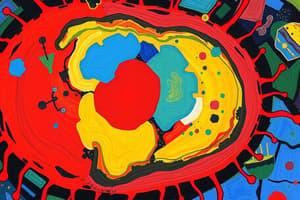Podcast
Questions and Answers
What is the primary role of mitochondria in the cell?
What is the primary role of mitochondria in the cell?
- Energy production (correct)
- Protein synthesis
- Cell division
- Nutrient absorption
Which structure within mitochondria is responsible for increasing the surface area for chemical reactions?
Which structure within mitochondria is responsible for increasing the surface area for chemical reactions?
- Cristae (correct)
- Matrix
- Outer membrane
- Inner compartment
What process do mitochondria initiate to help eliminate damaged cells?
What process do mitochondria initiate to help eliminate damaged cells?
- Mitosis
- Exocytosis
- Apoptosis (correct)
- Endocytosis
Which of the following is a function of mitochondria in liver cells?
Which of the following is a function of mitochondria in liver cells?
Which of the following statements about mitochondrial DNA is accurate?
Which of the following statements about mitochondrial DNA is accurate?
How do mitochondria contribute to cellular energy generation?
How do mitochondria contribute to cellular energy generation?
Which of the following processes are NOT associated with the functions of mitochondria?
Which of the following processes are NOT associated with the functions of mitochondria?
Which compartment within the mitochondria contains the dense material known as the matrix?
Which compartment within the mitochondria contains the dense material known as the matrix?
What is the primary function of the nucleus in a cell?
What is the primary function of the nucleus in a cell?
Which of the following organelles is responsible for energy production in the form of ATP?
Which of the following organelles is responsible for energy production in the form of ATP?
In the Fluid Mosaic Model, what primarily composes the cell membrane?
In the Fluid Mosaic Model, what primarily composes the cell membrane?
Which organelle is involved in protein synthesis and lipid metabolism?
Which organelle is involved in protein synthesis and lipid metabolism?
What role does the cytoplasm play within a cell?
What role does the cytoplasm play within a cell?
What is the main function of lysosomes?
What is the main function of lysosomes?
How does the Fluid Mosaic Model describe the arrangement of molecules in the cell membrane?
How does the Fluid Mosaic Model describe the arrangement of molecules in the cell membrane?
What is the primary purpose of the cell membrane?
What is the primary purpose of the cell membrane?
What is the primary function of chloroplasts in plant cells?
What is the primary function of chloroplasts in plant cells?
Which type of plastid is specifically involved in storing oils and fats?
Which type of plastid is specifically involved in storing oils and fats?
What is the size of eukaryotic ribosomes compared to bacterial ribosomes?
What is the size of eukaryotic ribosomes compared to bacterial ribosomes?
Which type of cytoskeletal filament is responsible for providing structural support to the cell?
Which type of cytoskeletal filament is responsible for providing structural support to the cell?
What is the role of ribosomes in eukaryotic cells?
What is the role of ribosomes in eukaryotic cells?
Which organelle contains its own DNA and is involved in energy production?
Which organelle contains its own DNA and is involved in energy production?
Which component of the cytoskeleton is primarily involved with intracellular transport?
Which component of the cytoskeleton is primarily involved with intracellular transport?
Which plastids are known for the coloration of fruits and flowers?
Which plastids are known for the coloration of fruits and flowers?
Flashcards are hidden until you start studying
Study Notes
Mitochondria
- Essential organelles known as the cell's powerhouse, critical for energy production.
- Typically cylindrical or sausage-shaped, ranging from 1.0 to 4.1 micrometers in length and 0.2 to 1.0 micrometer in diameter.
- Comprise a double-membrane structure: an outer membrane and an inner membrane creating two compartments—outer and inner.
- The inner compartment contains a matrix with dense material; the inner membrane forms cristae for increased surface area.
- Aerobic Respiration: Primary site for ATP generation by utilizing oxygen and nutrients.
- ATP Production: Occurs through biochemical reactions in the inner mitochondrial membrane, providing energy for cellular functions.
- Contain their own circular DNA, RNA, and ribosomes, suggesting semi-autonomous genetic machinery.
- Play a key role in apoptosis by releasing proteins that regulate programmed cell death, maintaining cellular health.
- In liver cells, involved in detoxifying ammonia, converting it into less harmful substances.
Nucleus
- Houses genetic material (DNA) and regulates cellular activities by controlling gene expression.
- Surrounded by a nuclear envelope, a double membrane that distinguishes the nucleus from the cytoplasm.
- DNA is organized into chromosomes within the nucleus.
Organelles
- Specialized structures performing specific cellular functions, including:
- Mitochondria: ATP generation.
- Endoplasmic Reticulum (ER): Protein synthesis (Rough ER with ribosomes) and lipid metabolism (Smooth ER without ribosomes).
- Golgi Apparatus: Modifies, sorts, and packages proteins and lipids for transport.
- Lysosomes: Contain enzymes that degrade waste materials and cellular debris.
- Chloroplasts (in plant cells): Site of photosynthesis, converting light energy to glucose.
Fluid Mosaic Model
- Proposed by Singer and Nicolson in 1972, describing the cell membrane's dynamic structure.
- Consists of a lipid bilayer with embedded proteins, resembling a mosaic, allowing lateral movement and flexibility.
Cell Membrane Functions
- Composed of 52% proteins and 40% lipids, serving as a physical barrier.
- Separates the internal cell environment from the external, providing protection and allowing independent cellular activities.
Plastids
- Double-membrane bound organelles found in plant cells and euglenoids, containing their own DNA and ribosomes.
- Types of plastids based on pigments:
- Chloroplasts: Involved in photosynthesis, containing chlorophyll and carotenoids.
- Chromoplasts: Store pigments (e.g., carotene), contributing to the coloration of plant structures.
- Leucoplasts: Colorless plastids for storage; include:
- Amyloplasts: Store starch.
- Elaioplasts: Store oils and fats.
- Aleuroplasts: Store proteins.
Ribosomes
- Sites of protein synthesis, composed of RNA and proteins, existing free in the cytoplasm or attached to the ER.
- Eukaryotic ribosomes are larger (80S) than bacterial ribosomes (70S), composed of two subunits (60S and 40S).
- Translate genetic information from mRNA into proteins essential for cellular functions.
Cytoskeleton
- Complex network of protein filaments in the cytoplasm of eukaryotic cells.
- Comprises three main types of filaments: microtubules, intermediate filaments, and microfilaments.
Studying That Suits You
Use AI to generate personalized quizzes and flashcards to suit your learning preferences.




